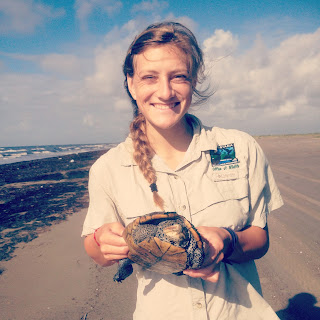The third week of our marine adventure was spent at FGCU Vester Marine Field Station. This week was a new adventure for us. We learned about so many different sides of marine biology that we had never considered before. Our first day was spent with Joanne Muller, a geologist, who taught us lots about history, sedimentation, and how storms (like hurricanes) affect our local environments. We went out into the estuary to take core samples. When taking them back to the lab, we discovered that the bottom of our core sample was about 7,000 years old! It was really interesting to be able to learn the story of the land just by looking at the different layers of the sediment. It was very different from what we’ve done the previous weeks. It was really interesting, but I don’t know if I see myself going into a geological field of marine biology. But it is cool how geology is one of those things that really ties everything together. It was a great experience getting to learn all about it.
The next day was also a new adventure. We were able to work with an archaeologist who also taught us lots about the history of the land. We were able to learn about the past civilizations who inhabited the islands around Fort Meyers. We were able to learn about their culture by studying the shells that were present. Most of the shells on the island were used by the Calusa Indians as tools. It was so interesting to take a look into the past. I’ve never really learned about archaeology, so it was really interesting to see how it ties into marine biology. Still, not really a field I would like to go into, but interesting to learn about.
The third day was spent exploring different parts of the estuaries. We started in the river and worked our way closer to the Gulf. At each site, we took water quality samples and noted all the aquatic life that was present. It was really interesting to see how the water quality changes so much as you get closer to the Gulf. It was cool to see how all the abiotic gradients changed from site to site. I really enjoy learning about estuaries, and I could definitely see myself pursuing a career doing research on them.
Then the fourth day was spent out on the boat shark fishing. I greatly enjoyed it. Our group ended up catching three sharks! The point of the study was to measure the mercury levels in the sharks. Mercury can have devastating affects on humans and animals if the levels are too high. It was cool how we would take the tissue samples, without really harming them. I’ve never really seen sharks much and I got to touch one! It was really awesome. Dr. Darren told us how to cheat the system a little. He said that if you want to work in a highly sought-after field in marine biology, you have to work with something that not many people want to work with. Like he works with mercury content levels and is able to incorporate sharks into his research. That was really great advice because, I’ve always wanted to work with large marine mammals and I’ve always been scared about getting a job because the demand is really great. I could definitely see myself incorporating sharks into my future study. I really had a lot of fun.
All in all, I think it was my favorite week so far just because we were able to be out on the boat and in the field every single day and I really enjoyed that. Also, I was able to learn about so many different fields in marine biology that I didn’t even know existed. It definitely broadened my horizons. I can’t wait to see what comes next!



































